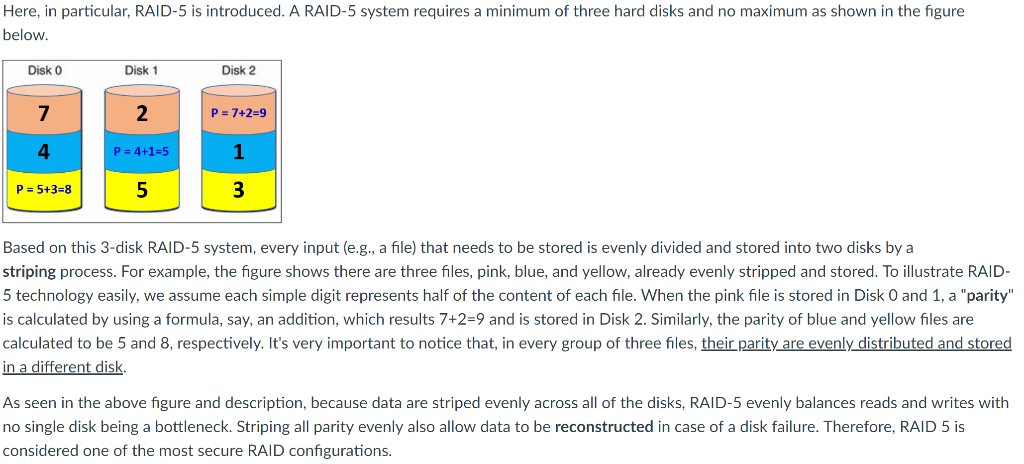Answered step by step
Verified Expert Solution
Question
1 Approved Answer
1) After the fourth file is stored, if the entire Disk 0 fails or crashes now, then, 7 of the pink file, 4 of the

1) After the fourth file is stored, if the entire Disk 0 fails or crashes now, then, "7" of the pink file, "4" of the blue file, the parity "8" of the yellow file, and some part of the 4th file all become inaccessible. If you represent the controller software of this RAID-5 system, describe how you would rebuild or reconstruct Disk 0 completely file by file.
Here, in particular, RAID-5 is introduced. A RAID-5 system requires a minimum of three hard disks and no maximum as shown in the figure below Disk 0 Disk 1 Disk 2 7 4 P 5+3-8 2 P 7+2-9 P 4+1-5 1 Based on this 3-disk RAID-5 system, every input (e.g., a file) that needs to be stored is evenly divided and stored into two disks by a striping process. For example, the figure shows there are three files, pink, blue, and yellow, already evenly stripped and stored. To illustrate RAID- 5 technology easily, we assume each simple digit represents half of the content of each file. When the pink file is stored in Disk 0 and 1, a "parity" is calculated by using a formula, say, an addition, which results 7+2-9 and is stored in Disk 2. Similarly, the parity of blue and yellow files are calculated to be 5 and 8, respectively. It's very important to notice that, in every group of three files, their parity are evenly distributed and stored in a different disk As seen in the above figure and description, because data are striped evenly across all of the disks, RAID-5 evenly balances reads and writes with no single disk being a bottleneck. Striping all parity evenly also allow data to be reconstructed in case of a disk failure. Therefore, RAID 5 is considered one of the most secure RAID configurations. Here, in particular, RAID-5 is introduced. A RAID-5 system requires a minimum of three hard disks and no maximum as shown in the figure below Disk 0 Disk 1 Disk 2 7 4 P 5+3-8 2 P 7+2-9 P 4+1-5 1 Based on this 3-disk RAID-5 system, every input (e.g., a file) that needs to be stored is evenly divided and stored into two disks by a striping process. For example, the figure shows there are three files, pink, blue, and yellow, already evenly stripped and stored. To illustrate RAID- 5 technology easily, we assume each simple digit represents half of the content of each file. When the pink file is stored in Disk 0 and 1, a "parity" is calculated by using a formula, say, an addition, which results 7+2-9 and is stored in Disk 2. Similarly, the parity of blue and yellow files are calculated to be 5 and 8, respectively. It's very important to notice that, in every group of three files, their parity are evenly distributed and stored in a different disk As seen in the above figure and description, because data are striped evenly across all of the disks, RAID-5 evenly balances reads and writes with no single disk being a bottleneck. Striping all parity evenly also allow data to be reconstructed in case of a disk failure. Therefore, RAID 5 is considered one of the most secure RAID configurationsStep by Step Solution
There are 3 Steps involved in it
Step: 1

Get Instant Access to Expert-Tailored Solutions
See step-by-step solutions with expert insights and AI powered tools for academic success
Step: 2

Step: 3

Ace Your Homework with AI
Get the answers you need in no time with our AI-driven, step-by-step assistance
Get Started


